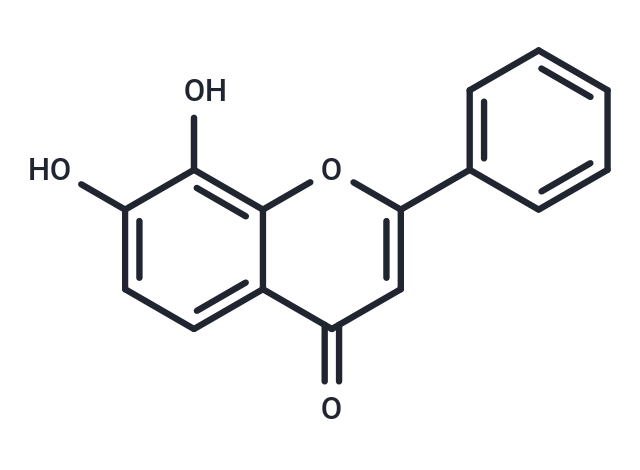Shopping Cart
Remove All Your shopping cart is currently empty
Your shopping cart is currently empty
7,8-Dihydroxyflavone (7,8-DHF) is a naturally-occurring flavone and exist in Tridax procumbens, Godmania aesculifolia, and primula tree leaves.

| Pack Size | Price | USA Warehouse | Global Warehouse | Quantity |
|---|---|---|---|---|
| 10 mg | $30 | In Stock | In Stock | |
| 50 mg | $68 | In Stock | In Stock | |
| 100 mg | $90 | In Stock | In Stock | |
| 1 mL x 10 mM (in DMSO) | $54 | In Stock | In Stock |
| Description | 7,8-Dihydroxyflavone (7,8-DHF) is a naturally-occurring flavone and exist in Tridax procumbens, Godmania aesculifolia, and primula tree leaves. |
| Targets&IC50 | TrkB receptor:320 nM(Kd) |
| In vitro | 7,8-DHF is one of the positive compounds that specifically activate TrkB, but not TrkA or TrkC, at a concentration of 250 nM. In addition to cortical and hippocampal neurons, 7,8-DHF also protects other cell types including the RGC (retinal ganglion cells) and PC12 cells from excitotoxic and oxidative stress-induced apoptosis and cell death. Thus, it has neuroprotective properties[1]. |
| In vivo | 7,8-Dihydroxyflavone is a bioavailable chemical that can pass through the BBB to provoke TrkB and its downstream PI3K/Akt and MAPK activation in mouse brain upon intraperitoneal or oral administration. 7,8-DHF promotes the survival and reduces apoptosis in cortical neurons of traumatic brain injury as administration of 7,8-DHF at 3 h post-injury reduces brain tissue damage via the PI3K/Akt pathway. Its treatment does not induce any apparent toxicity in mice and is not toxic to the mice during the chronic treatment. 7,8-DHF displays robust therapeutic efficacy toward Alzheimer's disease and inhibits obesity through activating muscular TrkB[1]. |
| Cell Research | PC12 cells are seeded in 96-well plates at 104/well. After pretreatment with 7,8-DHF (1-25 μM) for 1 h, the cells are exposed to 6-OHDA (100 μM) for subsequent 24 h. The PI3k inhibitor LY294002 or MEK inhibitor PD98059 is added 30 min before 7,8-DHF treatment. At the end of the experiment, PC12 cells are incubated with 20 μl of MTT solution (5 mg/ml in PBS) for 4 h at 37 ?C. The dark blue formazan product due to the reduction of MTT is dissolved in 150 μl of DMSO, and the absorbance at 570 nm is recorded with a microplate reader. The viability is expressed as the percentage of the untreated control cells. (Only for Reference) |
| Synonyms | 7,8-DHF |
| Molecular Weight | 254.24 |
| Formula | C15H10O4 |
| Cas No. | 38183-03-8 |
| Smiles | Oc1ccc2c(oc(cc2=O)-c2ccccc2)c1O |
| Relative Density. | 1.443 g/cm3 (Predicted) |
| Storage | keep away from moisture,store under nitrogen | Powder: -20°C for 3 years | In solvent: -80°C for 1 year | Shipping with blue ice/Shipping at ambient temperature. | ||||||||||||||||||||||||||||||||||||||||
| Solubility Information | H2O: < 1 mg/mL (insoluble or slightly soluble) DMSO: 45 mg/mL (177 mM), Sonication is recommended. Ethanol: 1 mg/mL (3.93 mM), Sonication is recommended. | ||||||||||||||||||||||||||||||||||||||||
| In Vivo Formulation | 10% DMSO+40% PEG300+5% Tween 80+45% Saline: 2 mg/mL (7.87 mM), Sonication is recommended. Please add the solvents sequentially, clarifying the solution as much as possible before adding the next one. Dissolve by heating and/or sonication if necessary. Working solution is recommended to be prepared and used immediately. The formulation provided above is for reference purposes only. In vivo formulations may vary and should be modified based on specific experimental conditions. | ||||||||||||||||||||||||||||||||||||||||
Solution Preparation Table | |||||||||||||||||||||||||||||||||||||||||
Ethanol/DMSO
DMSO
| |||||||||||||||||||||||||||||||||||||||||
| Size | Quantity | Unit Price | Amount | Operation |
|---|

Copyright © 2015-2025 TargetMol Chemicals Inc. All Rights Reserved.